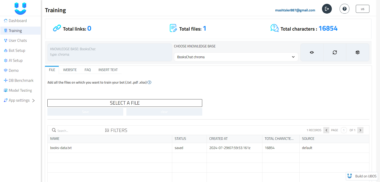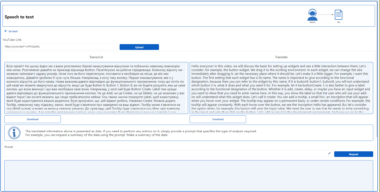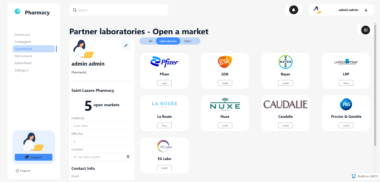Unveiling Google Cloud Monitoring Dashboard Samples for MCP Servers: A Deep Dive
In the realm of cloud computing, effective monitoring is paramount. It’s the vigilant guardian ensuring optimal performance, swift issue identification, and proactive resource management. Google Cloud Platform (GCP) offers a robust suite of monitoring tools, and among them, the Cloud Monitoring Dashboards stand out as a versatile solution. This document explores the power of Google Cloud Monitoring Dashboard Samples, particularly in the context of MCP (Model Context Protocol) Servers, and how they can be seamlessly integrated with the UBOS platform to unlock enhanced AI Agent development.
Understanding the Core Components
Before delving into the specifics, let’s establish a clear understanding of the key components:
- Google Cloud Monitoring Dashboards: These provide a visual representation of your cloud resources’ performance and health. They allow you to create custom charts, graphs, and alerts based on metrics collected from various GCP services.
- MCP (Model Context Protocol) Servers: MCP is an open protocol standardizing how applications provide context to LLMs (Large Language Models). Think of it as a bridge that allows AI models to access and interact with external data sources and tools.
- UBOS Platform: UBOS is a full-stack AI Agent Development Platform focused on enabling businesses to bring AI Agents into every department. It facilitates the orchestration of AI Agents, connects them with enterprise data, and allows the creation of custom AI Agents using your LLM models and Multi-Agent Systems.
Use Cases: Where Google Cloud Monitoring Dashboard Samples Shine for MCP Servers
The combination of Google Cloud Monitoring Dashboard Samples and MCP Servers opens up a plethora of use cases:
Real-time Performance Monitoring of MCP Servers:
- The Challenge: Ensuring the smooth operation of MCP Servers is crucial for AI agent functionality. Overloaded servers, network bottlenecks, or resource constraints can lead to performance degradation and inaccurate context delivery to LLMs.
- The Solution: By leveraging Cloud Monitoring Dashboards, you can create custom dashboards that display key performance indicators (KPIs) for your MCP Servers. These KPIs might include CPU utilization, memory consumption, network latency, request processing time, and error rates. The real-time visualization allows for immediate detection of anomalies and proactive intervention.
- Example: A sudden spike in CPU utilization on an MCP Server could indicate an unexpected surge in AI Agent requests. This would trigger an investigation into the cause, potentially leading to scaling up server resources or optimizing agent request handling.
Contextualizing AI Agent Behavior:
- The Challenge: Understanding why an AI Agent made a particular decision or took a specific action often requires tracing the flow of information through the MCP Server. This can be difficult without detailed monitoring data.
- The Solution: By integrating MCP Server logs and metrics into Cloud Monitoring Dashboards, you can create a comprehensive view of the data being accessed and processed by AI Agents. This allows you to correlate agent behavior with specific events or data points, providing valuable insights into the decision-making process.
- Example: An AI Agent responsible for fraud detection might flag a particular transaction as suspicious. By examining the MCP Server logs in the Cloud Monitoring Dashboard, you can trace the data used by the agent to reach this conclusion, verifying the accuracy of the analysis and identifying potential biases.
Predictive Scaling and Resource Optimization:
- The Challenge: Manually scaling MCP Server resources based on intuition is often inefficient and can lead to either over-provisioning (wasting resources) or under-provisioning (causing performance bottlenecks).
- The Solution: Cloud Monitoring Dashboards can be used to identify trends in MCP Server resource utilization over time. By analyzing these trends, you can predict future resource needs and automate scaling operations. This ensures that your MCP Servers always have the resources they need to handle AI Agent requests, without unnecessary costs.
- Example: If the Cloud Monitoring Dashboard shows a consistent increase in MCP Server traffic during peak business hours, you can configure an auto-scaling policy to automatically add more servers to the cluster during these times.
Troubleshooting and Root Cause Analysis:
- The Challenge: When an AI Agent malfunctions or produces unexpected results, it’s crucial to quickly identify the root cause. This can be a complex process, especially if the agent relies on data from multiple sources accessed through the MCP Server.
- The Solution: Cloud Monitoring Dashboards provide a central location for viewing all relevant metrics and logs related to the MCP Server and the AI Agent. This allows you to correlate different data points and quickly pinpoint the source of the problem.
- Example: If an AI Agent is consistently returning incorrect answers, you can use the Cloud Monitoring Dashboard to examine the data being passed to the agent by the MCP Server. This might reveal a data corruption issue, a misconfigured data source, or a bug in the agent’s code.
Security Monitoring and Threat Detection:
- The Challenge: MCP Servers can be vulnerable to security threats, such as unauthorized access or data breaches. Monitoring for suspicious activity is essential to protect sensitive data and prevent disruptions to AI Agent services.
- The Solution: Cloud Monitoring Dashboards can be configured to alert you to potential security threats, such as unusual login attempts, unauthorized data access, or denial-of-service attacks. By monitoring key security metrics, you can proactively identify and respond to security incidents.
- Example: An unusual number of failed login attempts to an MCP Server could indicate a brute-force attack. The Cloud Monitoring Dashboard can alert you to this activity, allowing you to take immediate action to block the attacker and protect your data.
Key Features of Google Cloud Monitoring Dashboard Samples for MCP Servers
The Google Cloud Monitoring Dashboard Samples provide a solid foundation for building custom monitoring solutions for your MCP Servers. Here are some key features:
- Pre-built Dashboards: The samples repository includes a collection of pre-built dashboards that cover common monitoring scenarios. These dashboards can be used as-is or customized to meet your specific needs.
- Customizable Metrics: You can create custom metrics based on data collected from your MCP Servers. This allows you to monitor specific aspects of server performance that are relevant to your AI Agent applications.
- Alerting and Notifications: You can configure alerts that trigger when certain metrics exceed predefined thresholds. This allows you to proactively identify and respond to issues before they impact your AI Agent services.
- Integration with Other GCP Services: Cloud Monitoring Dashboards seamlessly integrate with other GCP services, such as Cloud Logging and Cloud Trace. This provides a comprehensive view of your entire cloud environment.
- API Access: The Cloud Monitoring Dashboards API allows you to programmatically create, manage, and query dashboards. This enables you to automate monitoring tasks and integrate dashboards into your existing workflows.
Integrating with UBOS Platform for Enhanced AI Agent Development
The integration of Google Cloud Monitoring Dashboard Samples for MCP Servers with the UBOS platform unlocks even greater potential for AI Agent development.
- Centralized Monitoring: UBOS provides a centralized platform for monitoring all aspects of your AI Agent ecosystem, including MCP Servers, LLMs, and data sources. This simplifies monitoring and troubleshooting, and allows you to quickly identify and resolve issues.
- Unified Data Visualization: UBOS provides a unified data visualization interface that allows you to view metrics and logs from all your AI Agent components in a single pane of glass. This makes it easier to correlate data and gain insights into the behavior of your AI Agents.
- Automated Alerting and Remediation: UBOS allows you to configure automated alerts that trigger when certain events occur in your AI Agent ecosystem. You can also configure automated remediation actions to automatically resolve issues without human intervention.
- Enhanced Collaboration: UBOS provides a collaborative environment for AI Agent development, allowing teams to share dashboards, alerts, and remediation actions. This fosters collaboration and improves the efficiency of AI Agent development.
- AI-Powered Insights: UBOS leverages AI to provide insights into the behavior of your AI Agents. This can help you identify areas for improvement and optimize the performance of your agents.
Practical Steps to Implement Monitoring
- Deploy MCP Servers: Ensure your MCP Servers are properly deployed and configured within your Google Cloud environment.
- Import Dashboard Samples: Utilize the provided scripts and instructions to import the relevant dashboard samples into your Cloud Monitoring account.
- Customize Dashboards: Tailor the imported dashboards to reflect the specific metrics and KPIs that are most critical for your MCP Servers and AI Agent applications.
- Configure Alerts: Set up alerts to notify you of any anomalies or performance issues that require attention.
- Integrate with UBOS: Connect your Cloud Monitoring data to the UBOS platform to centralize monitoring and gain AI-powered insights.
Conclusion
Google Cloud Monitoring Dashboard Samples, when used in conjunction with MCP Servers and the UBOS platform, offer a powerful solution for monitoring the performance, behavior, and security of your AI Agent ecosystem. By leveraging the pre-built dashboards, customizable metrics, and integration capabilities, you can gain valuable insights into the health and efficiency of your AI Agents, enabling you to optimize their performance, troubleshoot issues quickly, and ensure the reliability of your AI-powered applications. Embrace this potent combination to unlock the full potential of AI Agent development and drive innovation within your organization. By implementing robust monitoring practices, you’re not just observing; you’re actively shaping the future of your AI initiatives.
Cloud Monitoring Dashboard Samples
Project Details
- zabn70/monitoring-dashboard-samples
- Apache License 2.0
- Last Updated: 1/7/2025
Recomended MCP Servers
获取当前环境的 mcp
alphavantage mcp server
An AI-powered task-management system you can drop into Cursor, Lovable, Windsurf, Roo, and others.
An MCP server for Raindrop.io
Blazing-fast, asynchronous MCP server for seamless filesystem operations.

PubMed MCP Server for accessing research papers
一个基于MCP协议的搜索服务实现,提供网络搜索和本地搜索功能,Cursor和Claude Desktop能与之无缝集成。

Memory for AI Agents; SOTA in AI Agent Memory; Announcing OpenMemory MCP - local and secure memory management.

 From vibe coding to vibe deployment. UBOS MCP turns ideas into infra with one message.
From vibe coding to vibe deployment. UBOS MCP turns ideas into infra with one message.





